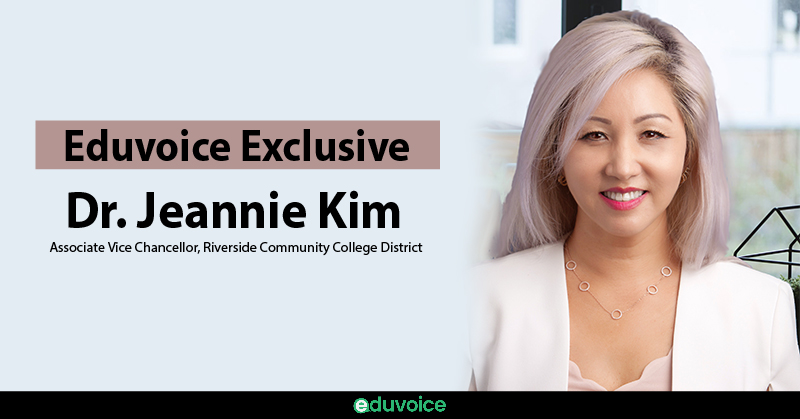Eduvoice exclusive interview

Dr. Jeannie Kim
Associate Vice-Chancellor, Riverside Community College District
Cultural anthropologist with degrees from UCLA and California State University, Fullerton
Has 25+ years of experience as a leader and change agent in higher education
introduction
Higher education in today’s world is reaching a new level. Nowadays developing countries are popping out with such great innovation that can change the entire education system of the world and lead it to a better future for every student.
But in this keeping up the innovation game, we have lost the true meaning of education and have made it more self-centered. To get the answer to this question, I got the opportunity to interview Dr. Jeannie Kim, who has a stellar record in making the education more holistic whilst keeping the innovation.

Sujata Mehta
“Innovation,” are we losing this over some time in Higher Education Globally?

Dr. Jeannie Kim
I think it’s now reviving in terms of higher education, previously innovation has not been synonymous with higher education. Because higher education has a cultural protocol of maintenance in the US, there are specific methods and practices to run the higher education system, which is not always right in recent times for developing countries.
Developing countries are re-establishing their systems and far more innovative. They are bringing up more creative methods of teaching through music, rhythm, and whatnot. It’s doing better than the US because they are taking to bring innovation now after seeing the developing countries.
The developing countries are bringing new methods after studying the present situation and identifying the beneficial techniques to educate students. There are strategies and tactics to develop any activities. The developing countries are doing vastly different things because they did research and then implemented. The will of the people has helped to bring a lot of change in the education system.
Now in the US, we are adopting the new protocols and systems discovered by the developing countries. The US is learning the new methods which are found by developing countries. It is essential to learn to update educating measures that are being identified by developing countries like India.
SUBSCRIBE TO OUR NEWSLETTER
Get latest updates about our Exclusive Interviews, News, Articles on Higher Education Sector.

Sujata Mehta
In your opinion, how important are the innovations for any culture’s development?

Dr. Jeannie Kim
It’s critical but essential. Higher education in the comprehensive system is set up to maintain the statistics. It’s mostly influenced by influential people who have made things easy for them. People who have money, power, influence are controlling the higher education system according to their comfort. This is not entirely correct. Innovation needs to take place.
“Education System is set up to maintain the status quo”
And has to have the structure and think of why we have structured this education system? Who is getting benefited?
It should be suitable for all kinds of people to learn and make a better world. The present structure is not ideal for everyone, and this barrier has to be broken. Diversity is critical to cultural development and innovation. People are not that easy to come out of cultural ethics, and they also wish to adopt modern concepts.
Here is where the irony is cultural diversity is the key to innovation. Different cultures bring different ideas to deliver innovation. A variety of thoughts, understanding, experience is vital.
For More Such Interviews Click Here
In Asian countries, the cultural effect is so strong, and that can bring innovation but is not easy. It is possible, and essential as well, but to collaborate with multiple cultures and bring the best out of it is a tough job. To analyze different cultures and ideate something new from them has to be done to modernize the culture and bring innovation as well.

Sujata Mehta
You are an expert in creating communities of innovation within bureaucratic and systemically entrenched organizational structures. 5 reasons one should initiate such communities on campuses.

Dr. Jeannie Kim
It goes back to my last comment. Higher education in the US and the rest of the world is usually reserved for the elite. For a long time. Previously it was the people with lots of money who could go for higher education. But now it has all changed. Now everyone is getting the opportunity. We have to look at how these things were established systematically. Why it is established and how it can be reframed.
- Because we want to create more equality to develop a social structure. Higher education can create that.
- Higher education has a responsibility to educate people to have more acceptance than we have. Previously we used to say we are tolerating differences, but it is not tolerating but acceptance, valuing the differences.
- We have a responsibility to care for this world. As a higher education institution, we have to work together to reach out to different cultures to be able to work simultaneously and synergistically. Higher education can do that with activities with student engagements.
- We are all part of communities. There was a higher education community, but now we are going beyond that. We become an ambassador for communities where we can work together for humanity in general.
- Humanity components. Even after developing the technologies, higher education has a responsibility to remind humans that as much as we are developing these things cutting edge structures, it cannot match humans. Humans are humans that cannot be replaced by any technology. Higher education is to put the humanistic piece forward and tell there is hope.

Sujata Mehta
If anyone wants to initiate it in any university or higher education institute, how to do that?

Dr. Jeannie kim

Sujata Mehta
You are a global speaker and delivered lectures in various countries, what general hurdles people are facing in the implementation?

Dr. Jeannie kim
The most significant part of change is ourselves. The reason is that if we think about bringing any change, we have to change for that. We have to have a different mindset; we have to adopt new things; we have to become an example of the change. We have to bring the change in us before we initiate to change the system.
When I was talking with educators, the most important feedback came in, that why do I have to change for the new system or the students?
I said you are willing your students to learn these things; then, you should be learning it as well. To answer their questions, you have to learn. To explain this new model of higher education, you have to learn. They will have a fund of knowledge to transfer to you so that you can become a better educator.
That’s the fundamental hurdle for us. We had to convince the educators to bring change in them to make them understand that to change the system, we have to change first and then proceed.

Sujata Mehta
Any interesting experience you want to share with our readers regarding the same.

Dr. jeannie kim
I would suggest people step outside of their comfort zone. Recently I came across the topic of networking. There are two things, strong ties, and loose ties. Strong ties are with the close ones whom you hang out with, live with love to spend time with; they are your close network. In case of loose ties, people we may have met through LinkedIn, we may not know each other very personally, but we have a secure professional connection through LinkedIn.
Though these people are new to us, they still will help us to innovate. Suppose a student moves out of town for higher study. There is value in that. We can get outside of our normal comfort zone. Being uncomfortable increases your awareness level and helps to be more accepting, adopt new. We get to learn to be self-sufficient, we get to learn new things with our experiences.
We understand the confidence to step out alone; we get the habit of being social or to gel up with people. I think this tendency to move out of comfort zone can bring you a hand full of benefit. I want to encourage this.
For More Such Articles, News Update, Events, and Many More Click Here





